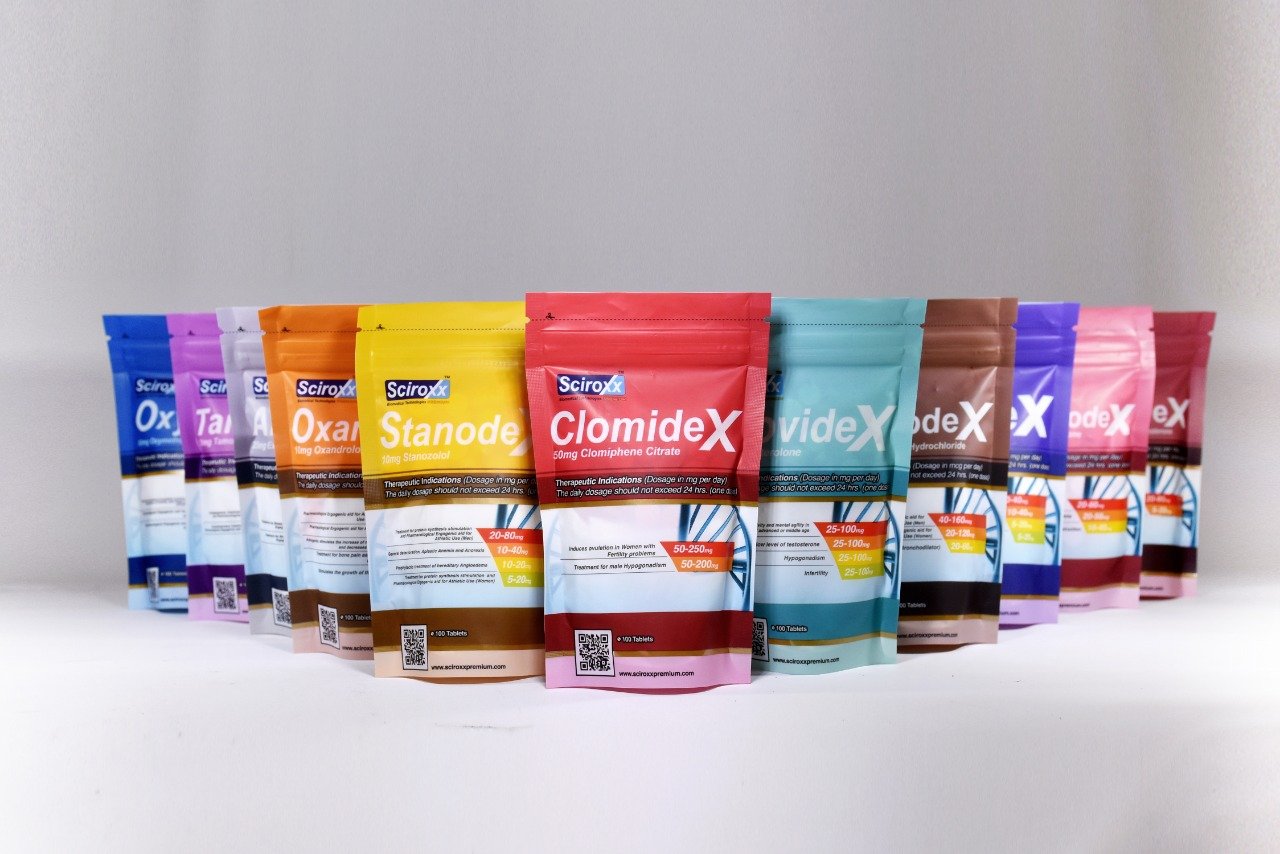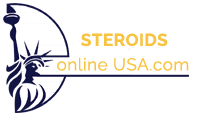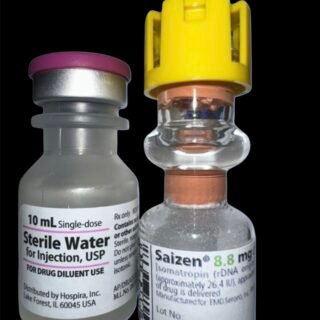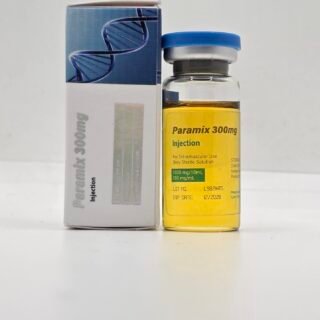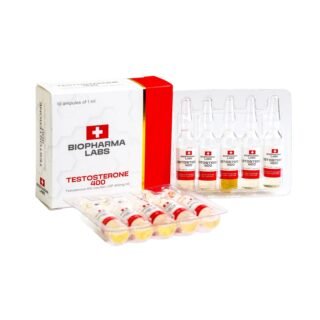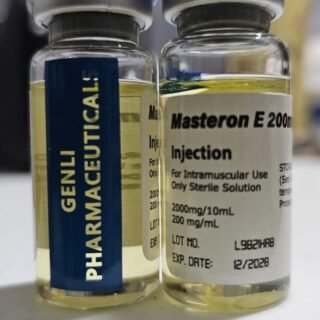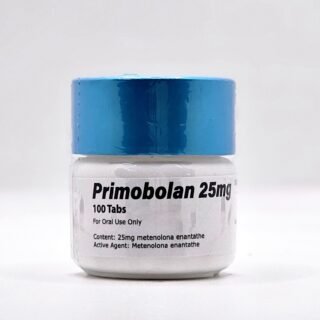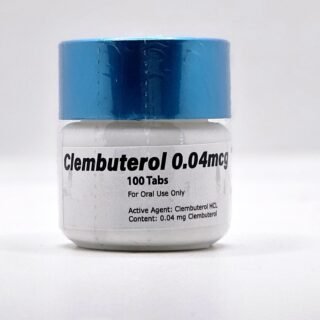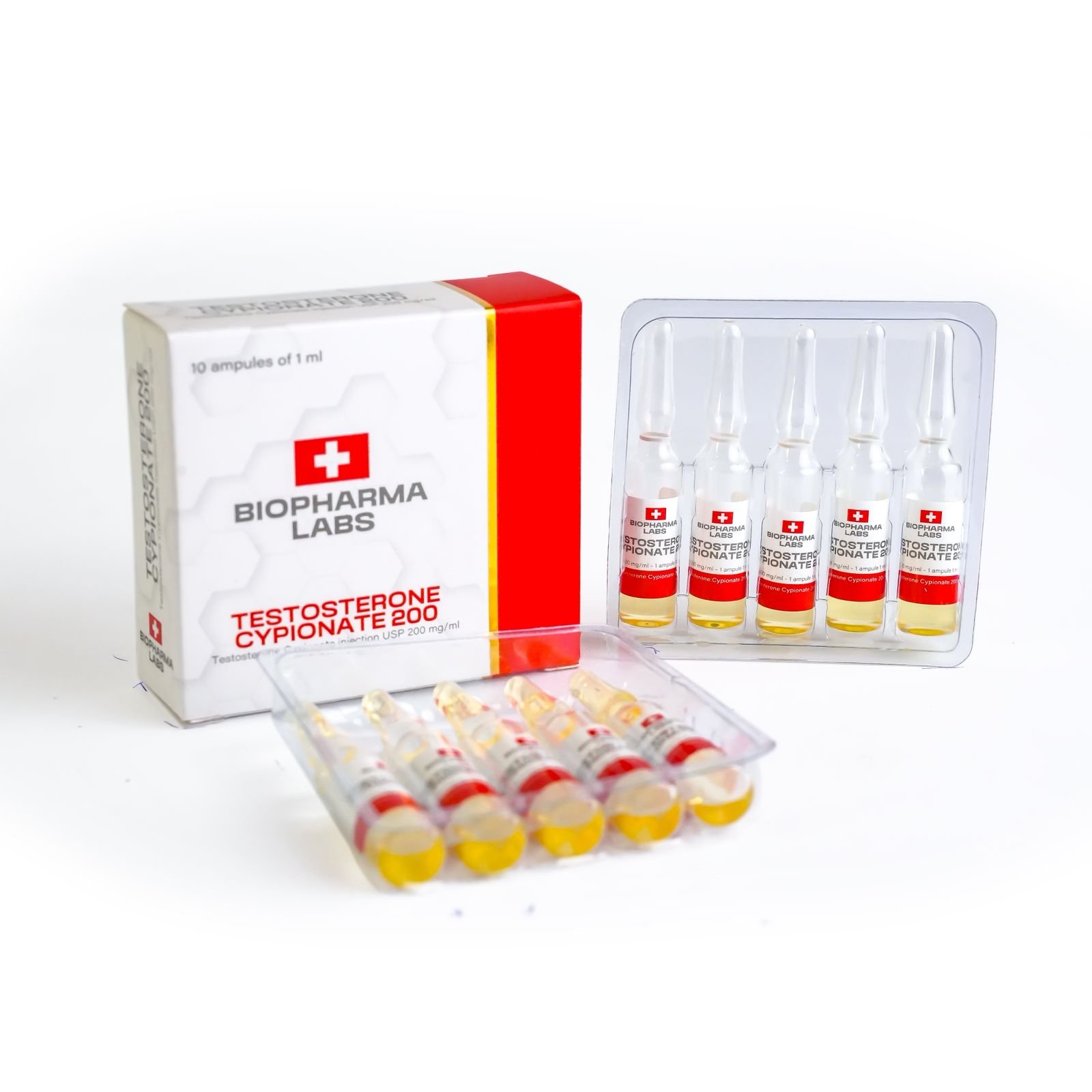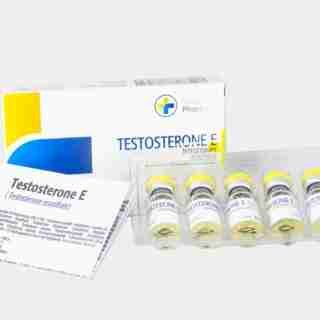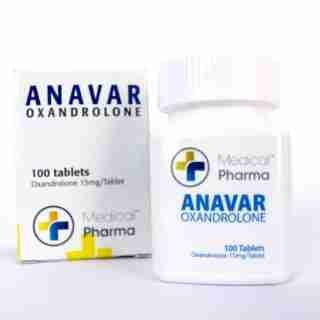Category
- Best Peptides for muscle growth
- Geno Pharma Domestic Warehouse 2 (Canada&USA)
- GP(Domestic Shipping US) Warehouse 1
- Human Pharma Premium
- Phar Labs Premium-Select
- Steroids on Sale USA, Real Steroids Online
- New arrivals in USA
- Most popular steroids in USA
- Antiestrogens / Gonadotropins
- Bangkok Steroid USA
- Biopharma Steroid USA
- British Dragon
- Anabolic Steroids for Horses
- Fat-burners
- Gen Pharma USA
- Medical Pharma Steroid USA
- Medical Tech Steroid USA
- Novocrine Steroids
- HGH USA
- Omega Labs Steroid USA
- Rotterdam Steroids USA
- SARMs USA
- Sciroxx
- Sydgroup Steroid USA
- Big vetenary Steroid USA
- Watson Steroids
- XT Labs Steroids
Most Popular steroids USA
-
 Saizen 8.8 mg (Somatropin) 26.4 UI Domestic USA
Saizen 8.8 mg (Somatropin) 26.4 UI Domestic USA
$115.00Original price was: $115.00.$98.00Current price is: $98.00. -
 PARAMIX 300 Genli Pharma – Trenbolone A, E & Hexa Mix 10 ml
PARAMIX 300 Genli Pharma – Trenbolone A, E & Hexa Mix 10 ml
$110.00Original price was: $110.00.$99.00Current price is: $99.00. -
 Testosterone 400 Biopharma 10 Ampoules
Testosterone 400 Biopharma 10 Ampoules
$99.00Original price was: $99.00.$75.00Current price is: $75.00. -
 Testosterone Cypionate 200 Biopharma 10 amp
Testosterone Cypionate 200 Biopharma 10 amp
$99.00Original price was: $99.00.$72.00Current price is: $72.00. -
 Drostanolone Enanthate 200mg 10 ml - Masteron Enanthate
Drostanolone Enanthate 200mg 10 ml - Masteron Enanthate
$110.00Original price was: $110.00.$90.00Current price is: $90.00. -
 Primobolan Pills 25mg 100 pills Domestic USA
Primobolan Pills 25mg 100 pills Domestic USA
$99.00Original price was: $99.00.$85.00Current price is: $85.00. -
 Clenbuterol for Sale 40mcg 100 Tabs - GP Premium Domestic USA
Clenbuterol for Sale 40mcg 100 Tabs - GP Premium Domestic USA
$99.00Original price was: $99.00.$65.00Current price is: $65.00.

Testosterone Cypionate 200 Biopharma 10 amp
$99.00 Original price was: $99.00.$72.00Current price is: $72.00.
Product Description – Testosterone Cypionate 200 Biopharma (10 Ampoules):
Testosterone Cypionate 200 Biopharma is a pharmaceutical-grade injectable testosterone formulation, delivering 200 mg/mL of testosterone cypionate per ampoule. Designed for intramuscular use, it is commonly prescribed as part of Testosterone Replacement Therapy (TRT) to treat male hypogonadism and restore healthy testosterone levels. Each pack contains 10 single-use ampoules, ensuring precise dosing and sterility. With its long-acting ester, this medication supports stable hormone levels, improved energy, libido, muscle mass, and overall well-being under medical supervision. For therapeutic use only; not intended for performance enhancement.
Share this page:
- Click to share on X (Opens in new window) X
- Click to share on Facebook (Opens in new window) Facebook
- Click to email a link to a friend (Opens in new window) Email
- Click to share on LinkedIn (Opens in new window) LinkedIn
- Click to share on Reddit (Opens in new window) Reddit
- Click to share on Pinterest (Opens in new window) Pinterest
- Click to share on Telegram (Opens in new window) Telegram
- Click to share on WhatsApp (Opens in new window) WhatsApp
- Click to share on Tumblr (Opens in new window) Tumblr
Testosterone Cypionate 200 Biopharma – Comprehensive Medical Overview
Testosterone Cypionate 200 Biopharma refers to a formulation of testosterone cypionate (typically 200 mg/mL), often supplied in packages of 10 ampoules. This long-acting injectable testosterone is widely used in medicine for hormone replacement. The following article provides a medically oriented overview of testosterone cypionate 200 mg (10 ampoule format), covering its history, clinical uses, benefits, risks, role in Testosterone Replacement Therapy (TRT), hormone level targets, scientific rationale, and proper usage guidelines. The information adheres to principles of Expertise, Authoritativeness, and Trustworthiness (EEAT), with citations to scientific and medical sources.
History of Testosterone Cypionate 200
Testosterone cypionate originated in the mid-20th century and was first synthesized in 1951. The Upjohn Company introduced it in the early 1950s as Depo-Testosterone, making it one of the first long-acting testosterone esters in the U.S. Following the 1935 discovery of testosterone, researchers in the 1950s developed longer-acting injectables like enanthate and cypionate to counter the hormone’s short half-life. Due to its similarity to enanthate, testosterone cypionate became especially popular in the U.S., often referred to as the “American” testosterone. Over the decades, it established itself as a standard in androgen therapy, supported by extensive clinical use and safety data.
Medical Benefits of Testosterone Cypionate 200 and Therapeutic Uses
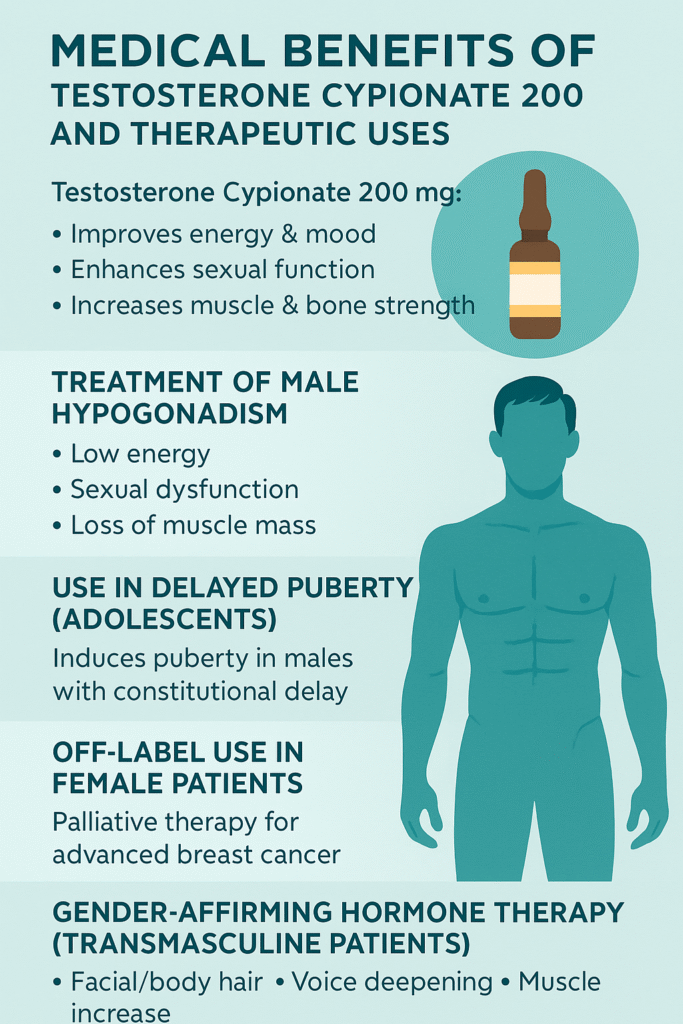
Testosterone cypionate 200 mg is primarily used for its androgenic and anabolic effects in patients who require testosterone supplementation. The chief therapeutic use is in treating male hypogonadism – a condition where the body cannot produce sufficient testosterone. In clinical practice, this means replacing deficient testosterone levels in men with disorders of the testes or pituitary gland (primary or hypogonadotropic hypogonadism). Restoring testosterone to normal levels helps induce and maintain male secondary sexual characteristics and normal physiology. Patients with low testosterone often suffer fatigue, low libido, erectile dysfunction, depressed mood, reduced muscle mass, and bone density loss; replacing testosterone can mitigate these issues.
Treatment of Male Hypogonadism
Testosterone cypionate is considered a first-line therapy in adult men with primary or secondary hypogonadism. By restoring testosterone to physiological levels, it helps reverse many of the hallmark symptoms of deficiency including:
Low energy
Sexual dysfunction
Loss of muscle mass and strength
Mood disturbances
Decreased bone mineral density
The therapeutic goal is to reestablish and maintain normal androgen levels to support overall male health and quality of life.
Use in Delayed Puberty (Adolescents)
Beyond hypogonadism in adult men, testosterone cypionate serves additional therapeutic purposes. Clinicians use it to initiate puberty in adolescent males with constitutional delay of puberty, closely monitoring the treatment under endocrinological supervision. In these cases, they administer low-dose testosterone on a controlled schedule to stimulate the development of secondary sexual characteristics and physical growth.
Off-Label Use in Female Patients
Testosterone cypionate has also been utilized (off-label) in certain female patients, such as palliative treatment for advanced breast cancer in postmenopausal women, where androgens can help slow tumor progression. Though not widely used, this application remains a part of the clinical record in select oncological cases.
Gender-Affirming Hormone Therapy (Transmasculine Patients)
Additionally, testosterone injections are a component of gender-affirming hormone therapy for transgender men (female-to-male), helping develop masculine characteristics such as facial/body hair, voice deepening, and muscle mass increase. This is considered an off-label but medically supervised use, and is widely supported in modern transgender healthcare protocols.
Age-Related Testosterone Decline (“Andropause”)
Routine use in age-related “andropause” (late-onset hypogonadism in older men) remains cautiously evaluated due to uncertain long-term benefits and potential cardiometabolic risks. Current guidelines recommend clear diagnostic confirmation and symptom correlation before initiating TRT in older males.
Summary of Medical Benefits and Ethical Use
In summary, medical benefits of testosterone cypionate therapy include improvements in sexual function, mood and energy, increased muscle mass and strength, improved bone mineral density, and even correction of anemia in men with true testosterone deficiency. These benefits translate into better quality of life when therapy is appropriately indicated and monitored.
It should be noted that testosterone cypionate is a prescription medication and should only be used under a physician’s guidance for approved indications. Non-medical use (such as for bodybuilding or a
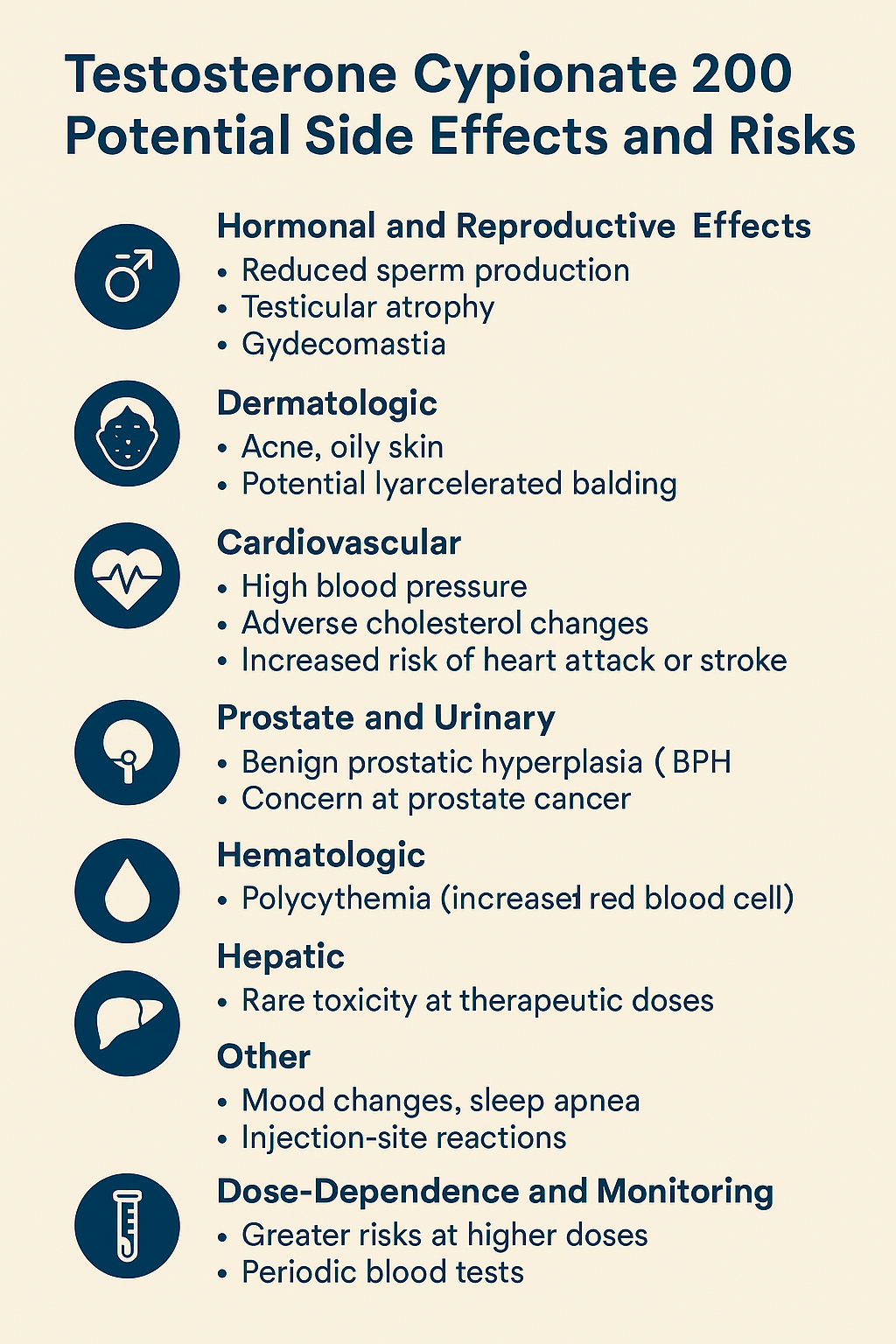
thletic performance) is illicit and discouraged, as the drug is a controlled substance in many countries.
Testosterone Cypionate 200 Potential Side Effects and Risks
While generally effective, testosterone cypionate therapy comes with a spectrum of potential side effects and risks. Patients and providers must weigh these risks against benefits when considering treatment. Some side effects are mild, whereas others can be more serious:
Hormonal and Reproductive Effects
Exogenous testosterone can cause feedback suppression of the body’s natural hormone production. This often leads to reduced sperm production and testicular atrophy (shrinkage of testes) because the injected testosterone suppresses the hypothalamic-pituitary-gonadal axis. For this reason, men who desire future fertility must use caution, as prolonged use can lower sperm counts (though usually reversible after stopping). It may also cause gynecomastia (enlargement of breast tissue in males), due to some testosterone converting to estrogen.
Dermatologic
Androgen therapy commonly causes acne and oily skin. Susceptible individuals might experience accelerated male-pattern baldness if genetically predisposed, since testosterone can convert to DHT which affects hair follicles.
Cardiovascular
Testosterone cypionate can influence cardiovascular risk factors. It may raise blood pressure and alter cholesterol levels (sometimes reducing HDL “good” cholesterol). High doses or misuse leading to supraphysiological levels have been associated with blood clots (e.g. deep vein thrombosis) and can potentially increase risk of heart attack or stroke. Patients should be vigilant for symptoms like leg swelling, chest pain, or shortness of breath. However, at therapeutic doses in hypogonadal men, evidence linking TRT to major cardiac events is mixed, and ongoing studies continue to evaluate long-term cardiovascular safety.
Prostate and Urinary
Since testosterone can stimulate prostate tissue, there is a concern for benign prostatic hyperplasia (BPH) – leading to symptoms like difficulty urinating in older men. Historically, there was fear that TRT might hasten prostate cancer, but current evidence has not shown a direct link between properly monitored TRT and new prostate cancer development. Nonetheless, TRT is contraindicated in men with known or suspected prostate cancer, and guidelines advise monitoring prostate health (e.g. PSA levels) during therapy as a precaution.
Hematologic
Testosterone stimulates red blood cell production. While this can correct anemia, it may lead to polycythemia (excess red blood cells) in some patients. Elevated hematocrit can thicken the blood and increase the risk of clotting events. Doctors typically monitor blood counts, and if hematocrit rises too high, the dose may be adjusted or phlebotomy (blood donation) may be recommended to reduce risk.
Hepatic
Unlike oral anabolic steroids, injectable testosterone cypionate is not 17-alpha-alkylated, so it is not highly toxic to the liver. Serious liver damage is rare at therapeutic doses. (Liver issues have been associated mainly with oral anabolic steroids, not injectable bioidentical testosterone).
Other
Additional side effects can include mood changes (irritability, aggression, or mood swings in some individuals), sleep apnea exacerbation, and injection-site reactions. Some men report increased aggression or libido changes. Pain, redness, or swelling can occur at the injection site, especially if proper technique is not followed. Allergic reactions are uncommon but possible (any injection could cause a reaction to the oil or preservative, presenting as rash or swelling).
Dose-Dependence and Monitoring
Importantly, most side effects are dose-dependent – meaning higher-than-physiologic doses (such as those abused by athletes) greatly increase risks. Significant anabolic effects and more severe adverse effects generally occur at supraphysiological testosterone levels, e.g. persistent blood levels above 1000 ng/dL (which typically corresponds to misuse of >300 mg of testosterone per week). In legitimate TRT, doctors aim to keep testosterone levels in the normal range to minimize such risks. Patients on testosterone cypionate require periodic monitoring: blood tests for testosterone levels, blood count, liver function, lipid profile, and prostate-specific antigen (PSA) (for men over 40) are commonly done to ensure safety.
Use in Testosterone Replacement Therapy (TRT)
General Overview of TRT and Testosterone Cypionate 200 mg
Testosterone Replacement Therapy (TRT) is the medical treatment for men with confirmed testosterone deficiency (hypogonadism) to restore hormonal levels and alleviate symptoms. Testosterone cypionate (200 mg strength) is one of the cornerstone options for TRT, especially in the United States, due to its efficacy and convenient dosing schedule.
Physiological Goals of TRT and Pharmacokinetics of Cypionate
In TRT, the aim is to restore testosterone to mid-normal levels. Testosterone cypionate, a long-acting ester, gradually releases bioidentical testosterone after intramuscular injection, maintaining stable levels over 1–2 weeks. Its 8-day half-life allows for dosing every 7–14 days, with typical regimens being 100 mg weekly or 200 mg biweekly. This helps mimic natural hormone rhythms while offering dosing flexibility.
Therapeutic Benefits in Hypogonadal Men
Testosterone cypionate in TRT effectively alleviates the symptoms of low testosterone in hypogonadal men. Patients often report improved libido and sexual function, better mood and cognitive focus, increased muscle mass and strength, reduced fat mass, and stronger bones throughout therapy. In men with anemia caused by testosterone deficiency, TRT raises hemoglobin to normal levels. These improvements explain why physicians prescribe TRT—restoring testosterone directly targets the root cause of symptoms in deficient patients and delivers clear, measurable health benefits (Section 6 will discuss the scientific evidence in more detail).
Diagnostic Confirmation and Individualization of Therapy
It is important to note that TRT is not a one-size-fits-all therapy. Physicians confirm a diagnosis of hypogonadism with blood tests (usually morning testosterone levels taken on two separate days) and clinical evaluation of symptoms. TRT is then tailored to the individual. Some men may use alternatives such as transdermal gels, patches, implants, or newer injectable formulations; however, testosterone cypionate injections remain one of the most cost-effective and reliable TRT methods.
Advantages of Testosterone Cypionate as a Delivery Method
The injectable route bypasses absorption issues (unlike gels or pills) and ensures the hormone is delivered into the bloodstream in a controlled depot form. This reliability, combined with decades of clinical experience, makes testosterone cypionate a preferred choice for many physicians treating testosterone deficiency.
Optimal and Pathological Hormone Levels in TRT
Understanding hormone levels in testosterone replacement therapy (TRT) is crucial to define what is considered “optimal” versus “pathological.” Testosterone levels in healthy men vary by age and individual, but for an adult male (19–39 years old), an accepted reference normal testosterone range is roughly 264 ng/dL to 916 ng/dL (nanograms per deciliter). Many laboratories and clinical guidelines consider a total testosterone level of around 300 ng/dL to be the lower limit of normal for adult men. Levels significantly below this (especially when accompanied by symptoms) are deemed pathologically low (hypogonadism), while levels within the mid- to upper-end of the range are considered physiologically normal.
Defining the Optimal Target Range in TRT
For men undergoing testosterone replacement therapy, the optimal target is to elevate testosterone levels into the mid-normal range — high enough to alleviate symptoms of deficiency, but not so high as to cause adverse effects. Clinical practice guidelines, such as those from the American Urological Association (AUA), recommend maintaining total testosterone in the middle third of the normal range — typically around 450–600 ng/dL.
This therapeutic goal is focused on physiological hormone restoration, not enhancement. In simple terms, TRT seeks to mimic the natural testosterone levels of a healthy young male, rather than push levels beyond normal. Achieving this range generally provides maximum benefits — improved mood, libido, energy, and body composition — while minimizing risk of side effects.
Recognizing Pathological Testosterone Levels
Pathological testosterone levels fall outside the physiological window. Specifically:
- Testosterone levels below ~250–300 ng/dL, especially when accompanied by symptoms, indicate a clinically low state and often justify initiating testosterone replacement therapy (TRT).
- Testosterone levels consistently above 1000 ng/dL exceed the therapeutic range, representing a supraphysiological state typically linked to anabolic steroid misuse or improper dosing.
Sustained supraphysiologic levels can cause serious health issues, including:
Erythrocytosis (excess red blood cells)
Increased risk of blood clots
Liver strain
Mood instability or aggression
A medical review cited in the text emphasizes that adverse effects and anabolic complications are most likely when total testosterone exceeds 1000 ng/dL, often due to very high weekly doses (hundreds of milligrams), not consistent with evidence-based TRT.
Individual Variability and Free Testosterone Considerations
It’s important to recognize that optimal testosterone levels may vary slightly by individual. Some men report feeling best in the upper-third of the normal range, while others stabilize in the mid-range. Hormone specialists tailor dosing based on:
Symptom resolution
Blood work results
Patient-specific variables
Clinicians sometimes measure free testosterone—the biologically active form not bound to proteins—in addition to total testosterone. This measurement becomes especially useful when SHBG (sex hormone-binding globulin) levels are abnormal. The Endocrine Society considers free testosterone levels below 5–9 ng/dL to be low.
Monitoring both total and free testosterone helps clinicians adjust TRT dosage to ensure effective, individualized treatment.
Conclusion: Keeping Hormone Levels in a Safe Physiological Window
In summary, testosterone replacement therapy aims to maintain hormone levels in a safe, normal physiological range. The term “optimal” refers to healthy, symptom-relieving levels that remain within the body’s natural boundaries, while “pathological” describes either untreated hypogonadism or excess testosterone from overuse.
By following established medical guidelines, conducting regular hormone monitoring, and adjusting testosterone cypionate dosing as needed, physicians can safely keep patients within the optimal hormone range for long-term health and therapeutic success.
Scientific Justification for Testosterone Cypionate 200 in TRT
The use of testosterone cypionate 200 mg in testosterone replacement therapy (TRT) is supported by extensive scientific and clinical evidence. Testosterone is a crucial hormone for male health, and its deficiency leads to well-documented symptoms and risks (fatigue, muscle loss, osteoporosis, sexual dysfunction, anemia, etc.). The scientific rationale for TRT is to restore testosterone to physiologic levels and thereby reverse or improve these conditions.
Evidence from Clinical Research on TRT
Multiple clinical trials and peer-reviewed studies have demonstrated the benefits of testosterone therapy in hypogonadal men. For instance, research has shown improvements in:
Sexual function (libido and erectile function)
Mood and cognitive performance
Lean body mass and muscle strength
Bone mineral density
Hemoglobin and red blood cell levels
One of the most referenced studies, The Testosterone Trials (a set of placebo-controlled studies published in 2016), found that one year of TRT in older men with low testosterone led to enhanced sexual activity, improved mood and depressive symptoms, increased bone density, and correction of unexplained anemia. These findings provide direct scientific proof that treating testosterone deficiency yields tangible clinical health benefits.
Why Testosterone Cypionate Is a Preferred Delivery Method
Bioidentical Hormone Advantage
Testosterone cypionate is simply testosterone esterified with cypionate, a compound that delays its release. Once administered, the body cleaves the ester, leaving natural, bioidentical testosterone. This is advantageous because:
It delivers the exact hormone the body produces endogenously
It functions through normal physiological pathways
It avoids the unpredictable effects of synthetic testosterone analogues
This biochemical compatibility makes testosterone cypionate an optimal choice in bioidentical hormone replacement therapy.
Pharmacokinetics and Convenience
The cypionate ester provides a long half-life when suspended in an oil-based depot. Scientific pharmacokinetic studies confirm:
It can be injected every 2 to 4 weeks and still maintain serum testosterone levels
Most men opt for weekly or biweekly injections to stabilize hormonal levels more precisely
It avoids the peaks and troughs associated with short-acting testosterone formulations
This long-acting profile offers both physiological stability and patient convenience, two key pillars in effective TRT protocols.
Support from Endocrine and Urology Clinical Guidelines
Several authoritative clinical guidelines support the use of injectable testosterone (including cypionate) as first-line therapy:
The Endocrine Society and American Urological Association (AUA) both include intramuscular testosterone in their official TRT guidelines
These guidelines affirm that when prescribed correctly — for men with confirmed low testosterone and matching symptoms — cypionate can significantly improve quality of life and mitigate long-term risks of hypogonadism
Further, these institutions highlight that testosterone cypionate allows precise dose titration and monitoring, which enhances individualized treatment plans and patient safety.
Long-Term Safety Record and Physician Trust
Testosterone cypionate has been used for over 70 years in clinical endocrinology. Its:
Safety profile is well-characterized
Side effects at physiological doses are rare and manageable
Efficacy has been confirmed across decades of clinical use
This long-standing use has resulted in widespread medical community trust, meaning:
Physicians are comfortable prescribing and monitoring this compound
Patients benefit from established best practices, lab monitoring, and structured follow-ups
Unlike newer formulations with limited real-world data, testosterone cypionate 200 mg remains a gold standard injectable TRT option.
In summary, the scientific justification for using testosterone cypionate in TRT rests on: (1) solid evidence that normalizing testosterone in deficient patients leads to meaningful health improvements; (2) the pharmacological suitability of testosterone cypionate to deliver the hormone effectively and safely; and (3) strong clinical consensus and guideline support. By using testosterone cypionate, doctors are able to replace “like with like” – giving the body back what it is missing – in a controlled manner that has been proven to enhance patients’ health and quality of life.
Proper Use, Dosage, and Administration (200 mg 10 Ampoules)
Administration Route
Only administer testosterone cypionate via intramuscular (IM) injection — never intravenously. Inject the solution deep into a large muscle, ideally the gluteal muscle (buttocks), although trained individuals may also use the thigh (vastus lateralis) or deltoid. A deep IM injection allows the medication to form a depot in the muscle tissue, enabling slow and steady absorption into the bloodstream.
Aseptic Technique
Use a new, sterile needle and syringe for each ampoule. Before injection, cleanse the vial/ampoule top (if it has a rubber stopper) and the skin at the injection site with an alcohol swab to prevent infection. Ampoules are single-use glass vials; one must carefully snap open the neck of the ampoule (using a gauze or ampoule opener if provided) and withdraw the solution with a syringe. Exercise caution to avoid cuts from the glass. Once opened, an ampoule cannot be stored – it should be used immediately and any leftover solution discarded.
Dosage Regimen
The dosage and injection schedule for Testosterone Cypionate 200 should be determined by a doctor, as it varies by individual. A common TRT regimen is 100 mg weekly or 200 mg every two weeks. With 200 mg ampoules, some inject the full dose biweekly, while others split it weekly. Ampoules are single-use and not resealable. Always follow medical guidance—self-adjusting doses can lead to harmful hormone levels and side effects.
Handling and Preparation
Inspect each ampoule before use. The solution is typically a clear to yellowish oily liquid. If you notice any particles or crystallization in the liquid, do not inject immediately. Warming and gently shaking the ampoule can redissolve crystals that occasionally form in storage (crystals can appear if the product was stored in cold conditions). Do not use the ampoule if the solution remains cloudy, discolored, or contains undissolvable precipitate – in such cases, obtain a new ampoule.
Injection Technique
Attach an appropriate needle (often a 22–23 gauge, 1–1.5 inch needle for gluteal IM injections). After drawing up the medication, tap the syringe to remove air bubbles. Insert the needle into the muscle at a 90-degree angle using a quick dart-like motion. Some providers suggest aspirating (pulling back slightly on the plunger after insertion) to ensure no blood is drawn back – this confirms the needle is not in a blood vessel. Then slowly inject the oil over 20–30 seconds; injecting slowly helps the muscle absorb the oil and reduces post-injection pain. Withdraw the needle and apply pressure with a clean cotton or gauze. Used needles and ampoules should be disposed of in a sharps container.
After Injection Care
It’s normal to have mild soreness at the injection site. Massage the area gently to help disperse the oil. Rotate injection sites (alternate between left and right gluteal muscles, for example) to avoid irritation or muscle scarring. If significant pain, swelling, or redness occurs in the days after injection, or if you develop fever, contact your healthcare provider as these could indicate an injection-site infection or reaction.
Storage
Keep the ampoules at room temperature (around 20–25°C / 68–77°F). They should be protected from light (the medication may be supplied in amber glass or a box for this reason). Do not freeze the ampoules, and keep them out of reach of children. Each ampoule is labeled for “Rx only” use – meaning it should only be used under a doctor’s prescription.
Monitoring and Follow-up
While on therapy with testosterone cypionate, regular follow-up is important. Periodic blood tests will check testosterone levels (to ensure the dosing is correct), as well as other parameters like blood count (hematocrit), PSA (for prostate health in older men), liver enzymes, and lipid profile. Also, never share your medication with others; it is prescribed based on individual needs and sharing is illegal and unsafe. If a dose is missed, contact your provider for guidance – generally it should be taken as soon as possible, but doubling up doses is not advised.
By adhering to these usage guidelines, patients can safely benefit from their Testosterone Cypionate 200 mg/1 mL ampoules. Proper administration technique maximizes the medication’s effectiveness and minimizes complications such as injection pain or infection. Always follow the specific instructions given by your healthcare provider, as there may be individualized adjustments to the general guidance above.
Frequently Asked Questions About Testosterone Cypionate 200 Biopharma
What is Testosterone Cypionate 200 Biopharma used for?
Testosterone Cypionate 200 Biopharma is primarily used in Testosterone Replacement Therapy (TRT) to treat male hypogonadism. It helps restore healthy testosterone levels and alleviate symptoms such as fatigue, low libido, reduced muscle mass, and mood disturbances.
How is Testosterone Cypionate 200 Biopharma administered?
This product is administered via intramuscular injection. Each ampoule contains 200 mg/mL of testosterone cypionate and is designed for single use to maintain sterility and dosing accuracy.
How often should I inject Testosterone Cypionate 200mg?
The frequency of injection depends on individual medical guidance, but most patients inject 100 mg weekly or 200 mg every two weeks. Your doctor will determine the best schedule based on your hormone levels and symptoms.
What are the benefits of using Testosterone Cypionate?
When prescribed correctly, testosterone cypionate can improve libido, energy, muscle mass, bone density, mood, and overall well-being in men with clinically low testosterone levels.
Is Testosterone Cypionate 200 Biopharma safe?
Yes, when used under medical supervision. However, it may cause side effects like acne, increased red blood cell count, or suppression of natural testosterone production. Regular monitoring is essential to ensure safe use.
Sources:
- Nieschlag E. The history of testosterone. Endocrine Abstracts, 2005 – Long-acting testosterone esters introduced in the 1950s.
- Formulation Compounding Pharmacy. Testosterone Cypionate Injections – General Information. (n.d.) – Depo-Testosterone introduced by Upjohn in early 1950s; therapeutic uses in hypogonadism.
- Wikipedia. Testosterone cypionate. (Accessed 2025) – Synthesized 1951 and medical use; considered bioidentical; primary use in androgen replacement; side effect of sperm production suppression; pharmacokinetic half-life ~5–8 days.
- DailyMed (U.S. NIH). Testosterone Cypionate Injection Label. Updated 2010 – FDA-approved indications (primary/hypogonadotropic hypogonadism); half-life ~8 days and dosing interval; contraindications and warnings (polycythemia, prostate cancer, etc.); suggested replacement dose 50–400 mg IM every 2–4 weeks.
- American Urological Association (AUA) Guideline 2018. Testosterone Deficiency. – Recommends mid-normal target levels 450–600 ng/dL in TRT; monitor hematocrit (polycythemia risk); no evidence TRT causes prostate cancer; documented improvements in libido, erectile function, anemia, bone density, lean mass with TRT.
- Endocrine Society Press Release, 2017. Landmark Study Defines Normal Ranges for Testosterone – Harmonized normal range in young men ~264–916 ng/dL.
- Park HJ et al. Evolution of Guidelines for TRT. J. Clin. Med. 2019 – Consensus that low testosterone ~ <300 ng/dL is diagnostic cutoff for hypogonadism in most guidelines.
- Cleveland Clinic. Testosterone Injections – Patient Information. (Elsevier, 2025) – Lists side effects (blood clots, high blood pressure, acne, site reactions, etc.) and cautions (not for use in women, not for athletic use).
Author :
Michael E. Collins, C.N.
Certified Nutritionist – Expert in Performance Nutrition & Applied Pharmacology
Michael E. Collins is a licensed clinical nutritionist with over 16 years of experience in the fields of sports nutrition, bodybuilding, and metabolic optimization. With a dual foundation in academic science and hands-on coaching, he specializes in the intersection of nutritional biochemistry and pharmacological enhancement for athletes and high-performance individuals.
Over the past decade and a half, Michael has guided clients ranging from amateur competitors to elite athletes, offering precision-based protocols that combine diet, supplementation, and performance-enhancing strategies. His expertise includes the responsible integration of compounds such as SARMs, peptides, and anabolic agents, always within a medically-informed, safety-first framework.
Michael is recognized for his evidence-driven approach, practical application of cutting-edge research, and his commitment to helping individuals achieve peak physical condition without compromising long-term health.
Related products
Testosterone Online Purchase Enanthate 250mg/ml MP
$93.00Add to cartC26H40O3 = 400.6.
CAS — 315-37-7.
ATC — G03BA03.
ATC Vet — QG03BA03.USP 31(Testosterone Enanthate). A white or creamy-white crystalline powder. It is odourless or has a faint odour characteristic of heptanoic acid. Insoluble in water; very soluble in ether; soluble in vegetable oils. Store at a temperature of 2°to 8°. Protect from light.
Testosterone E contains: 250mg 250 mg / ml Testosterone Enanthate.
Anavar For Sale Online 15mg/100tabs MP | Purchasing Anavar US
$99.00Add to cartAnavar (Oxandrolone) 15mg 100 Tablets – Medical Pharma
Anavar (Oxandrolone) 15mg by Medical Pharma is a high-quality anabolic steroid known for its muscle-preserving and performance-enhancing properties. With 100 tablets per bottle, each containing 15mg of Oxandrolone (NSC-67068, SC-11585), it supports lean muscle retention, fat loss, and recovery while minimizing water retention. Its mild androgenic profile makes it a preferred choice for both men and women looking for effective yet controlled performance enhancement.
Mastabol 100mg/ml 10ml – Medical Pharma Buy in USA
$93.00Add to cartMastabol 100mg/ml (10ml) by Medical Pharma is a premium Drostanolone Propionate formula designed to enhance muscle hardness, strength, and fat loss. Ideal for cutting cycles, it promotes a lean, defined physique while maintaining high performance. Available for secure purchase in the USA with fast shipping and a trusted buying process.
Primobolan 100mg/ml 10ml – Medical Pharma Anabolic Steroids USA
$103.00Add to cartMetenolone Enantate; Enantato de metenolona; Enantato de Metilandrostenolona;
Méténolone, Enantate de; Metenoloni Enantas; Methenolone; Enanthate (USAN); Methenolone Oenanthate; NSC-64967; SH-601; SQ-16374. 17β-Hydroxy-1-methyl-5α-androst-1-en-3-one-heptanoate.
Pay with WISE APP or Remitly
Pay with WISE App or Remitly
Fast money transfers from USA for fast delivery of steroids
Secure delivery in USA
100% reliable shipping in USA
24x7 Support
Online 24 hours
Low cost delivery
Great shipping prices in USA
BULK ORDER DISCOUNT
If you are a reseller in the USA you can get a special DISCOUNT, we can give you up to 50% or more on bulk orders. If you want to make a bulk order, we can negociate for orders of over USD$4,000, contact us by email.
Steroids info
